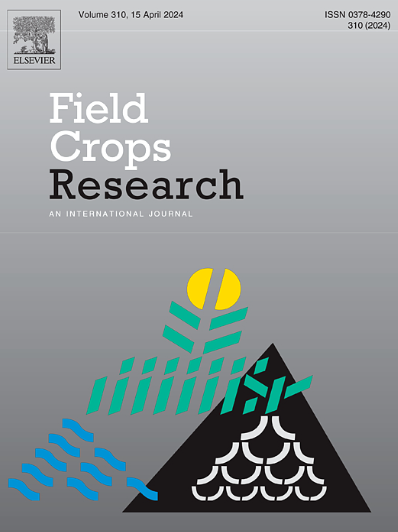Optimizing the ratio of controlled release urea relative to normal urea to improve the crop yield and N recovery efficiency – A global meta-analysis
IF 5.6
1区 农林科学
Q1 AGRONOMY
引用次数: 0
Abstract
Context
Controlled release urea combined with normal urea (CN) has huge potential for wider applications as the sustained nitrogen (N) supply can meet the N demands of most crops and its cost is relatively affordable compared with the single application of controlled release urea (CRU). However, it is currently unclear how to balance the crop yield, N recovery efficiency (NRE), and N uptake in response to CN. Furthermore, the lack of a global meta-analysis on the ratio of CRU to normal urea (NU) under different environmental conditions hinders the determination of the optimal CRU:NU ratio.
Objective and methods
Therefore, we established a database containing 2143 observations from 345 studies published up to 2024 to conduct a global meta-analysis and explore the effects of three different ratios of CRU relative to NU (CRU:NU < 1, CRU:NU = 1, and CRU:NU > 1) on the crop yield, NRE, and N uptake, as well as identifying the main factors that influenced the effectiveness of CN.
Results
We found that compared with NU, CN significantly increased the crop yield, NRE, and N uptake by 6.50 %, 22.88 %, and 9.31 %, respectively, and the effect of CRU:NU = 1 was generally greatest. The effects of different CRU:NU ratios on improvements in the crop yield, NRE, and N uptake depended on the mean annual precipitation, mean annual temperature, soil organic matter content, total N content, and pH. Furthermore, CN was suitable for most crops, but the appropriate duration of N release from CRU should be selected based on the length of the crop growth cycles. Moreover, the fertilizer combination of 199.83–222.34 kg N ha–1, 92.76–126.15 kg P2O5 ha–1, and 120 kg K2O ha–1 N could maximize the effectiveness of CN. In addition, CN reduced the accumulated soil nitrate (NO3–-N), accumulated N2O emissions, and NH3 volatilization by 8.24 %, 12.28 %, and 27.17 %, respectively, and improved the economic benefits by 13.77 %.
Conclusions and implications
Therefore, combining CRU with NU at an appropriate ratio can improve the crop productivity, as well as reducing environmental risks and improving the economic benefits, thereby supporting its widespread application.
优化控释尿素与普通尿素的配比以提高作物产量和氮素恢复效率——一项全球荟萃分析
控释尿素与普通尿素(CN)联合施用具有巨大的应用潜力,因为其持续的氮素供应可以满足大多数作物的氮素需求,而且与单独施用控释尿素(CRU)相比,其成本相对低廉。然而,如何平衡作物产量、氮素恢复效率(NRE)和氮素吸收对CN的响应,目前尚不清楚。此外,缺乏对不同环境条件下CRU与正常尿素(NU)比率的全球荟萃分析,阻碍了最佳CRU:NU比率的确定。因此,我们建立了一个数据库,包含截至2024年发表的345项研究中的2143项观察结果,进行了全球荟萃分析,并探讨了三种不同CRU相对于NU的影响(CRU:NU <;1、CRU:NU = 1、CRU:NU >;1)对作物产量、氮还原率和氮素吸收的影响,以及确定影响氮肥有效性的主要因素。结果与NU相比,CN可显著提高作物产量、氮素吸收率和氮素吸收率,分别提高6.50 %、22.88 %和9.31 %,且CRU:NU = 1的效果普遍最大。不同CRU:NU配比对作物产量、氮素吸收率和氮素吸收的影响取决于年平均降水量、年平均气温、土壤有机质含量、全氮含量和ph值。此外,CN适用于大多数作物,但应根据作物生长周期的长短选择合适的CRU释氮时间。其中,199.83 ~ 222.34 kg N ha-1、92.76 ~ 126.15 kg P2O5 ha-1和120 kg K2O ha-1 N的施肥组合能最大限度地提高氮肥的利用效率。此外,CN使土壤硝态氮(NO3—N)、N2O排放和NH3挥发分别减少8.24 %、12.28 %和27.17 %,经济效益提高13.77 %。结论与意义选择合适的比例,将CRU与NU结合使用可提高作物产量,降低环境风险,提高经济效益,支持其推广应用。
本文章由计算机程序翻译,如有差异,请以英文原文为准。
求助全文
约1分钟内获得全文
求助全文
来源期刊

Field Crops Research
农林科学-农艺学
CiteScore
9.60
自引率
12.10%
发文量
307
审稿时长
46 days
期刊介绍:
Field Crops Research is an international journal publishing scientific articles on:
√ experimental and modelling research at field, farm and landscape levels
on temperate and tropical crops and cropping systems,
with a focus on crop ecology and physiology, agronomy, and plant genetics and breeding.
 求助内容:
求助内容: 应助结果提醒方式:
应助结果提醒方式:


